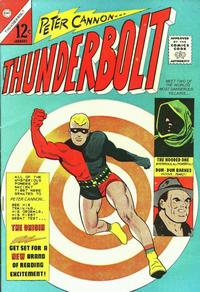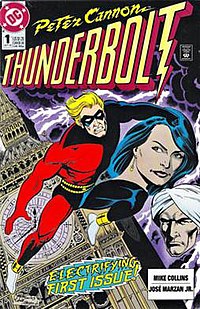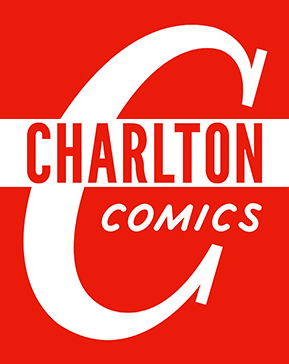
Charlton Comics was an American comic-book publishing company that existed from 1945 to 1986, having begun under a different name: T.W.O. Charles Company, in 1940. It was based in Derby, Connecticut. The comic-book line was a division of Charlton Publications, which published magazines, puzzle books, and briefly, books. It had its own distribution company.
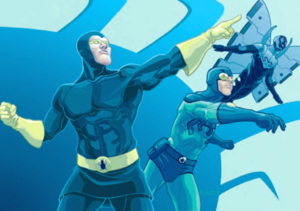
Blue Beetle is the name of three fictional superheroes appearing in a number of American comic books published by a variety of companies since 1939. The most recent of the companies to own rights to Blue Beetle is DC Comics, which bought the rights to the character in 1983, using the name for three distinct characters over the years.

Donald L. Heck was an American comics artist best known for co-creating the Marvel Comics characters Iron Man, the Wasp, Black Widow, Hawkeye and Wonder Man and for his long run penciling the Marvel superhero-team series The Avengers during the 1960s Silver Age of comic books.
Judomaster is the name of several superheroes appearing in American comic books published by DC Comics.
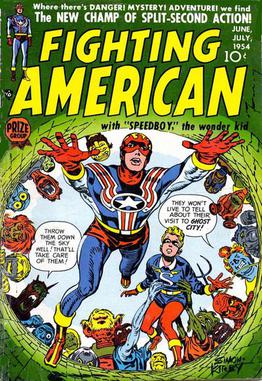
Fighting American is a superhero created in 1954 by the writer-artist team of Joe Simon and Jack Kirby. Published by the Crestwood Publications imprint Prize Comics, it was, contrary to standard industry practices of the time, creator-owned. Harvey Comics published one additional issue in 1966. One final inventoried tale was published in 1989, in a Marvel Comics hardcover collection of all the Fighting American stories.
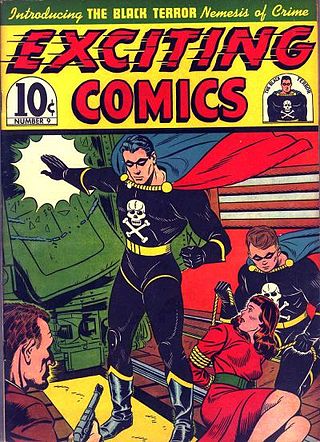
The Black Terror is a fictional comic book superhero who originally appeared in Exciting Comics #9, published by Nedor Comics in January 1941. The character was popular, and on the strength of the Black Terror's sales, Nedor made Exciting Comics a monthly magazine starting with issue #11.

Daredevil is a fictional superhero created by Jack Binder, who starred in comics from Lev Gleason Publications during the 1930s–1940s period historians and fans call the Golden Age of comic books before being retroactively established into the Image Universe by Image Comics in the 1990s as its first character. The character is unrelated to Marvel Comics' Daredevil.
Peter A. Morisi, who sometimes went by the pseudonym PAM, was an American comic book writer and artist who also spent much of his professional life as a New York City Police Department officer. He is best known as creator of the 1960s Charlton Comics series Peter Cannon ... Thunderbolt, a thoughtful superhero comic that contained some of the earliest respectful invocations of Eastern mysticism in American pop culture.

Mr. Muscles is a fictional comic book superhero created in 1956 by writer Jerry Siegel for Charlton Comics, and drawn by Bill Fraccio for the first of two issues of his namesake comic, and by the team of penciler Charles Nicholas and inker Vince Alascia for the second. A young Dick Giordano provided the premiere issue's cover. Siegel, who co-created Superman, wrote both issues featuring Charlton's own muscleman.
William Fraccio was an American comic book artist whose career stretched from the 1940s Golden Age of comic books through 1979, when he turned to producing advertising art and teaching. He is best known for his 23-year run at Charlton Comics, where he illustrated, among many other things, the first two professional stories of future Marvel Comics editor-in-chief Roy Thomas.
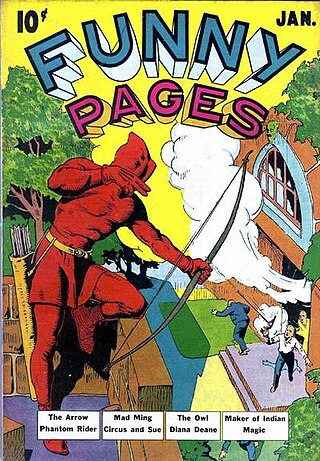
The Arrow is a fictional superhero created during the Golden Age of Comic Books. He was the first superhero published by Centaur Publications.

Johnny Dynamite is a comic book private detective character created by writer Ken Fitch and artist Pete Morisi. Johnny Dynamite appeared in 1953's Dynamite #3-9 published by Comic Media and in Johnny Dynamite #10-12 published by Charlton Comics. He also appeared in Charlton's Foreign Intrigues #13-15.

The Skyman is a fictional comic book superhero that appeared stories during the Golden Age of Comic Books. Created by writer Gardner Fox and artist Ogden Whitney, the character first appeared in the Columbia Comics omnibus title Big Shot Comics #1. He is unrelated to the DC Comics character.

Amazing-Man is a comic book superhero whose adventures were published by Centaur Publications during the 1930s to 1940s in the Golden Age of Comic Books. Historians credit his creation variously to writer-artist Bill Everett or to Everett together with Centaur art director Lloyd Jacquet. Amazing-Man first appeared in Amazing-Man Comics #5.
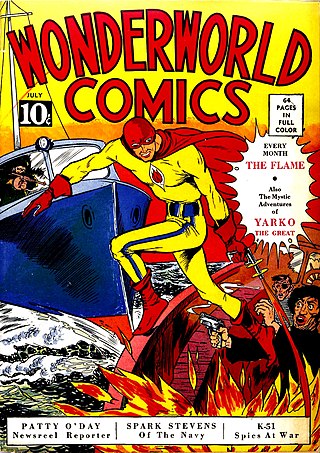
The Flame is a superhero that appeared in American comic books published by Fox Feature Syndicate. The Flame first appeared in Wonderworld Comics #3 and was created by writer Will Eisner and artist Lou Fine. The Flame became Wonderworld's primary character.

Miss Masque is a fictional masked crime-fighter. She originally appeared in comic books published by Nedor Comics, and was later revived by AC Comics, America's Best Comics, and Dynamite Entertainment.
Aaron P. "Pat" Boyette was an American broadcasting personality and news producer, and later a comic book artist best known for two decades of work for Charlton Comics, where he co-created the character the Peacemaker. He sometimes used the pen names Sam Swell, Bruce Lovelace, and Alexander Barnes.

Silver Streak is a fictional superhero character created by Joe Simon that first appeared in Silver Streak Comics #3, from Lev Gleason Publications. He is believed to be the second-ever comic book superhero whose primary power is speed; All-American Publications' The Flash preceded him by two months. However, Silver Streak beat out National Allied Publications' Johnny Quick as the first superhero whose two powers were speed and flight. Silver Streak has a kid sidekick called "Mercury" ; he is also assisted by a falcon named "Whiz".
The Little Wise Guys is a group of fictional characters, created by Charles Biro, who first appeared in comic books from Lev Gleason Publications in the 1940s and Image Comics in the 2010s.

Dan Garret or Dan Garrett is a fictional superhero, appearing in American comic books published by multiple companies, including Fox Comics, Charlton Comics, and DC Comics. Garret was created by Charles Nicholas Wojtkoski, and made his first appearance in Fox's Mystery Men Comics #1 during the Golden Age of Comic Books. Garrett is the first character to become the superhero Blue Beetle, predating Ted Kord and Jaime Reyes.
